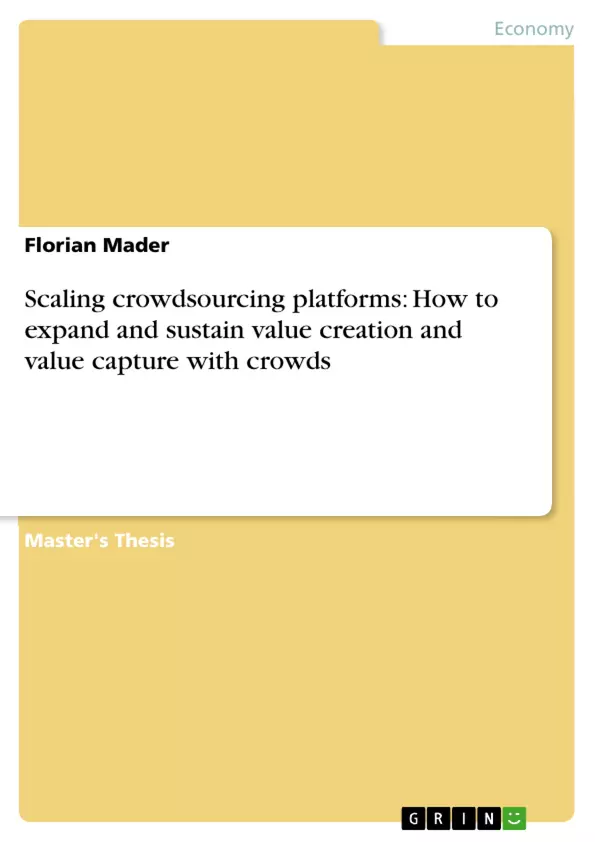Over the last years more and more companies have opened up their corporate boundaries and have built their business model upon the crowd. The creation of a crowdsourcing platform is a challenging endeavor, because on the one hand the crowd needs to be involved in the value creation process. On the other hand, to successfully keep them on the platform, the crowd needs also to be involved in the value capture process. To identify the main challenges a crowdsourcing platform needs to overcome in order to scale effectively, qualitative interviews with platform managers and founders, experts and platform participants were conducted. The results illustrate that the most important factors concering successful scaling are platform infrastructure, communication and community management.
Table of Contents
- Introduction
- Problem definition
- Method
- Contribution
- Structure
- Theoretical foundation on the value creation and value capture process of crowdsourcing platforms
- Open innovation
- Three core processes in open innovation
- Outside-in process
- Inside-out process
- Coupled process
- Crowdsourcing
- Different types of crowdsourcing
- User motivation
- Crowdsourcing based business models
- The value creation process
- Scaling crowdsourcing platforms
- Why scale matters
- Challenges during creation
- Ongoing challenges
- Empirical analysis on scaling crowdsourcing platforms effectively
- Research approach
- Research findings
- Understanding of scaling
- Critical mass and chicken & egg problem
- Lack of quality of core value unit
- Lack of motivation and engagement
- Paths to scale crowdsourcing platforms
- Lessons learned
- Limits of scaling
- Conclusion
- Theoretical implications
- Managerial implications
- Create platform awareness
- Provide technological infrastructure
- Create platform activity
- Involve top creators
- Refresh your community
- Deploy community for quality control
- Educate your crowd
- Encourage desired crowd behavior
- Award the crowd
- Create a strong community culture
- Main challenges for crowdsourcing platforms
- Limitations and outlook
Objectives and Key Themes
This master thesis examines the challenges crowdsourcing platforms face in scaling their operations, focusing on the intricate interplay between value creation and value capture. The study aims to understand how these platforms can expand and sustain their operations while effectively leveraging the contributions of the crowd. The research delves into the key factors crucial for platform success, including platform infrastructure, communication strategies, and community management. The thesis aims to provide valuable insights for platform managers and founders to navigate the complexities of scaling a crowdsourcing platform effectively.
- The value creation and capture processes in crowdsourcing platforms
- The role of open innovation in crowdsourcing
- The challenges of scaling crowdsourcing platforms
- The importance of platform infrastructure, communication, and community management
- The key factors influencing user motivation and engagement
Chapter Summaries
- Introduction: This chapter introduces the research topic and outlines the thesis's core problem definition, methodology, contribution, and structure. It sets the stage for exploring the complexities of scaling crowdsourcing platforms.
- Theoretical foundation: This chapter delves into the theoretical framework surrounding the value creation and capture processes within crowdsourcing platforms. It explores the concepts of open innovation and crowdsourcing, examining different types of crowdsourcing, user motivation, and crowdsourcing-based business models. The chapter also addresses the challenges associated with scaling these platforms and lays the groundwork for the empirical analysis to follow.
- Empirical analysis: This chapter presents the empirical analysis on scaling crowdsourcing platforms effectively. It outlines the research approach, including the qualitative interview methodology used to gather data from platform managers, founders, experts, and participants. The analysis reveals key insights regarding the understanding of scaling, critical mass, the chicken & egg problem, quality concerns, motivation and engagement, paths to scaling, lessons learned, and the limitations of scaling crowdsourcing platforms.
Keywords
This master thesis focuses on the critical aspects of scaling crowdsourcing platforms, encompassing key concepts such as value creation, value capture, open innovation, crowdsourcing, user motivation, platform infrastructure, communication strategies, community management, and the challenges associated with achieving sustainable growth in this dynamic environment. The research draws on insights from qualitative interviews with platform managers, founders, experts, and participants, shedding light on the essential factors for successful scaling.
- Citar trabajo
- Florian Mader (Autor), 2016, Scaling crowdsourcing platforms: How to expand and sustain value creation and value capture with crowds, Múnich, GRIN Verlag, https://www.grin.com/document/342674



